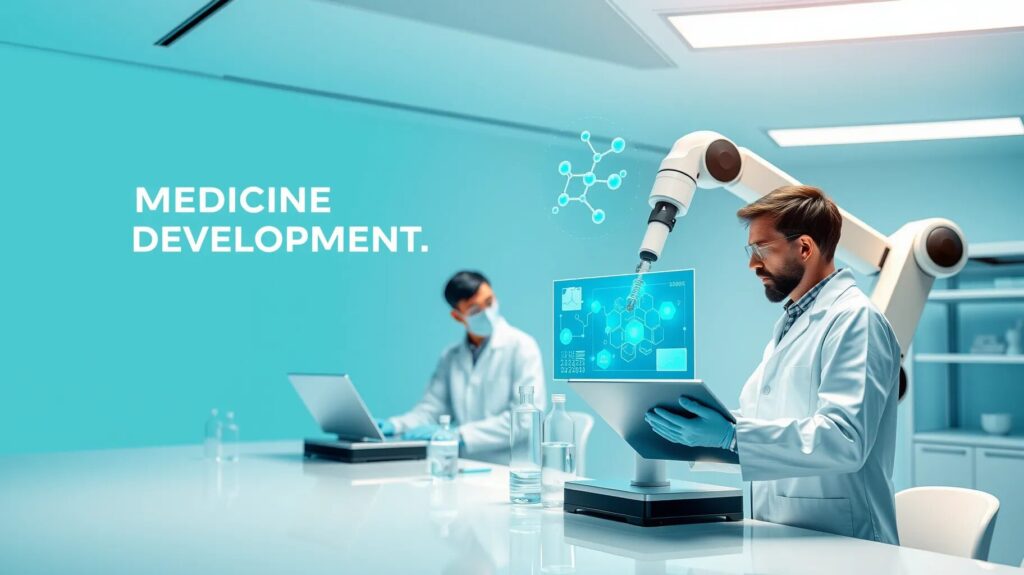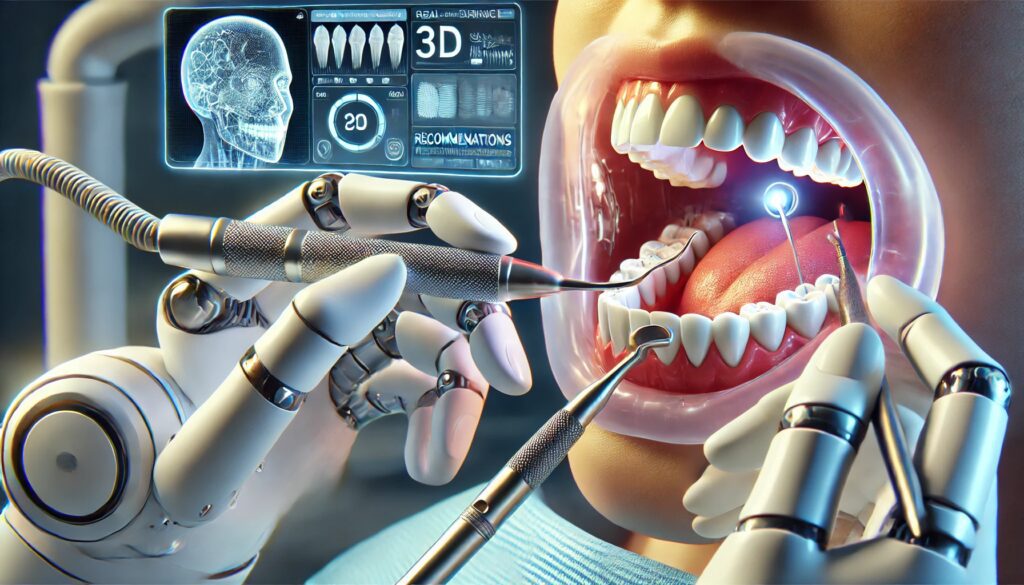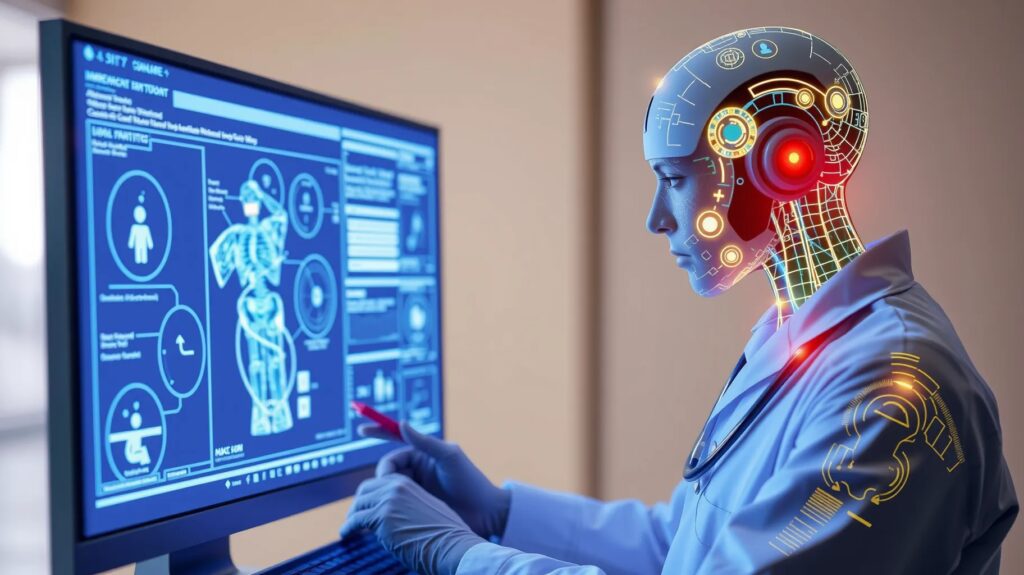
Medical imaging has always been a cornerstone of accurate diagnosis in healthcare. With the rise of telemedicine, the integration of artificial intelligence (AI) is revolutionizing how radiology and pathology are practiced remotely
From improving diagnostic accuracy to accelerating workflows, AI is setting a new benchmark for healthcare delivery.
How AI is Revolutionizing Medical Imaging
Enhanced Image Analysis
AI algorithms excel at processing medical images with speed and precision, often identifying patterns beyond the capability of the human eye.
- Radiology: AI models, such as convolutional neural networks (CNNs), analyze X-rays, MRIs, and CT scans to detect anomalies like tumors or fractures. For instance, Google DeepMind has shown remarkable success in detecting eye diseases from retinal scans.
- Pathology: Digital pathology now uses AI to detect cancerous cells in histopathology slides with extraordinary accuracy, helping pathologists focus on critical cases.
AI’s ability to spot subtle changes in images reduces diagnostic errors, making it a valuable asset in remote telemedicine consultations.
Faster Diagnosis and Reporting
AI-powered tools automate time-consuming tasks, enabling quicker diagnosis.
- In radiology, AI can triage emergency cases like stroke detection by flagging critical scans for immediate review, speeding up life-saving interventions.
- Pathology applications allow automated image segmentation, pinpointing suspicious regions in biopsies for further examination.
For example, platforms like Aidoc and Viz.ai use AI to prioritize cases in radiology workflows, dramatically reducing the time-to-diagnosis for urgent conditions.
Supporting Telemedicine Scalability
The demand for telemedicine has surged, especially in underserved areas where specialists may not always be available. AI bridges this gap by providing:
- Remote diagnostic support: AI-powered platforms allow radiologists and pathologists to evaluate and annotate images from anywhere.
- Second opinions: AI tools offer insights that supplement expert reviews, enhancing confidence in diagnoses.
For instance, a rural clinic can upload chest X-rays to an AI system that flags pneumonia indicators, ensuring timely treatment recommendations.
The Role of AI in Radiology
Transforming Image-Based Diagnosis
Radiology deals with massive datasets, making AI a perfect match.
- AI models trained on diverse datasets can detect lung cancer, cardiovascular diseases, and musculoskeletal injuries with exceptional accuracy.
- Tools like Qure.ai have demonstrated efficacy in identifying tuberculosis from chest X-rays, even in resource-constrained environments.
AI also assists in measuring and quantifying lesions, providing radiologists with precise metrics to track disease progression.
Reducing Radiologist Burnout
Radiologists face increasing workloads due to the rising demand for imaging studies. AI alleviates this burden by automating repetitive tasks:
- Identifying normal scans, so radiologists focus only on abnormal findings.
- Generating preliminary reports with suggested interpretations, streamlining workflows.
This shift reduces fatigue while enhancing productivity, critical for maintaining high-quality care in telemedicine.
The Role of AI in Pathology
Advancing Digital Pathology
AI-driven digital pathology transforms traditional methods by digitizing slides and enabling robust analyses.
- Algorithms can detect cancer subtypes, grade tumors, and even predict therapy responses by analyzing molecular patterns.
- For instance, Paige AI has developed systems that identify prostate cancer in histopathology slides, aiding in early detection.
AI tools also support remote consultations, enabling pathologists to analyze and share high-resolution images with peers globally.
Integrating Genomics and Imaging
One of AI’s groundbreaking roles in pathology is the integration of genomics and imaging data.
- AI models can correlate molecular data with visual findings, providing deeper insights into disease mechanisms.
- This combination paves the way for precision medicine, where treatments are tailored to an individual’s genetic profile.
For example, AI can suggest targeted therapies for breast cancer patients by linking genetic mutations with tissue characteristics.
Challenges in AI-Driven Medical Imaging
Data Privacy and Security
Handling sensitive medical data requires strict compliance with privacy regulations like HIPAA and GDPR.
- AI systems often rely on cloud storage for image analysis, increasing the risk of data breaches.
- Encryption and anonymization techniques must be applied to protect patient information during telemedicine consultations.
For example, platforms like Arterys use secure cloud computing environments to ensure compliance while enabling AI-assisted imaging workflows.
Variability in Image Quality
Telemedicine often relies on imaging devices in remote or under-resourced areas, where image quality may be inconsistent. AI systems must:
- Adapt to suboptimal images by using noise-reduction algorithms.
- Train on diverse datasets to handle variations in image resolution and lighting.
For instance, AI tools for portable X-ray machines in rural areas use preprocessing steps to standardize image quality before analysis.
Limited Access to Annotated Data
AI models require vast amounts of annotated data to train effectively, but creating labeled datasets in medical imaging is time-intensive.
- Collaboration between healthcare institutions and AI developers is essential to build robust training datasets.
- Synthetic data generation using techniques like GANs (Generative Adversarial Networks) can help fill gaps.
An example is AI applications in rare diseases, where synthetic data simulates conditions to expand training datasets.
Ethical Considerations in Diagnosis
AI is not infallible, and over-reliance on its predictions can lead to ethical dilemmas.
- Misdiagnoses from AI systems may delay critical treatments, especially in telemedicine, where face-to-face verification is absent.
- A collaborative approach, where AI supports but does not replace human judgment, is crucial.
For example, AI tools in radiology generate confidence scores for predictions, allowing radiologists to weigh AI’s input appropriately.
Future Trends in AI-Driven Medical Imaging
Federated Learning for Secure Data Sharing
Federated learning allows AI models to train on decentralized datasets without transferring sensitive information.
- Hospitals can collaborate globally to enhance AI performance while maintaining data privacy.
- This approach is particularly useful in telemedicine, where data is sourced from geographically dispersed locations.
For example, federated learning is being explored in oncology to improve tumor detection algorithms across multiple institutions.
Real-Time Imaging and Diagnosis
Advances in edge computing are bringing AI capabilities directly to imaging devices.
- Portable ultrasound machines equipped with AI can provide real-time feedback, aiding in immediate diagnosis during telemedicine visits.
- Real-time AI analysis is especially valuable in emergency scenarios like stroke management, where time is critical.
Platforms like Butterfly Network already deploy handheld devices integrated with AI for on-the-spot diagnostic support.
Multi-Modal AI Systems
The future of AI in medical imaging lies in combining data from various sources:
- Radiology images, pathology slides, and EHRs (Electronic Health Records) can be integrated for comprehensive insights.
- Multi-modal systems enable holistic diagnoses, particularly in complex conditions like cancer and autoimmune diseases.
For example, AI might combine CT scan data with biopsy results to predict how a tumor will respond to chemotherapy.
Democratizing Access to Diagnostics
AI-powered imaging tools are making advanced diagnostics more accessible:
- Low-cost AI solutions are bringing radiology and pathology capabilities to underserved regions.
- Open-source AI models, like those developed by organizations such as Radiopedia, are democratizing access to medical expertise globally.
For instance, AI-based tuberculosis detection tools are being deployed in remote clinics, enabling faster treatment for at-risk populations.
AI is not just a tool—it’s a transformative force in telemedicine, radiology, and pathology. With its ability to bridge gaps, enhance accuracy, and scale healthcare delivery, AI is paving the way for a future where quality care is accessible to all.
Unlocking AI’s Potential: Insights in Radiology and Pathology
AI for Personalized Telemedicine
AI in medical imaging is driving personalized care by integrating imaging data with patient-specific details like medical history, lifestyle factors, and genetic information.
- In radiology, AI can recommend follow-up imaging protocols tailored to a patient’s unique risk profile.
- In pathology, AI can combine molecular markers with histopathology images to suggest customized treatment plans for cancers.
Example: AI might analyze a patient’s lung CT scan alongside their smoking history to predict future risks and recommend preventive measures.
AI-Powered Workflow Optimization for Remote Teams
AI not only enhances diagnostics but also optimizes workflows in telemedicine setups. For example:
- Automating the triage of imaging studies ensures urgent cases (e.g., stroke or internal bleeding) are prioritized for review by remote specialists.
- AI can auto-generate structured radiology reports, significantly reducing documentation time during teleconsultations.
Example: Platforms like Aidoc identify critical findings (e.g., pulmonary embolism) and notify radiologists instantly, even during off-hours.
AI’s Role in “Smart Second Opinions”
AI acts as a digital second opinion, a crucial feature in telemedicine where patients may lack access to subspecialists.
- AI provides probabilistic insights that radiologists or pathologists can compare with their findings, reducing human bias.
- This capability builds trust in diagnoses for patients in remote or underserved areas.
Example: In mammography, AI might detect microcalcifications indicative of early-stage breast cancer, prompting a pathologist to double-check the findings.
Overcoming Bias in Remote Diagnostics
AI helps counter biases that can occur in telemedicine, such as over-reliance on limited local data or devices with subpar calibration.
- Training AI on diverse datasets ensures equitable performance across demographics, imaging modalities, and geographic regions.
- AI algorithms can adjust for variations, such as differences in imaging protocols between urban and rural clinics.
Example: AI designed to detect tuberculosis on chest X-rays performs well in rural areas by learning from datasets sourced globally, ensuring accuracy even in varied environments.
Accelerating Research with AI in Imaging
AI enables faster discovery of new biomarkers and disease correlations in imaging data, which directly benefits telemedicine.
- AI can sift through thousands of scans to identify emerging patterns linked to diseases, paving the way for early interventions.
- Pathology is seeing breakthroughs in predicting treatment responses based on AI-analyzed tissue samples.
Example: AI might reveal that a certain imaging pattern in liver scans correlates with early signs of non-alcoholic fatty liver disease (NAFLD), allowing remote clinicians to act sooner.
Digital Twin Technology in Medical Imaging
AI is enabling the use of digital twins—virtual models of patient anatomy—for telemedicine.
- In radiology, AI constructs 3D models from CT/MRI scans, enabling remote specialists to simulate surgical procedures or predict outcomes.
- In pathology, digital twins of tissue samples can model disease progression or treatment response without invasive procedures.
Example: A digital twin of a patient’s lung could simulate the effects of different therapies for emphysema, assisting remote pulmonologists in optimizing care plans.
AI in Collaborative Telemedicine Networks
AI supports collaborative diagnostics by connecting multiple specialists in real-time.
- AI highlights findings that radiologists and pathologists in different locations can review together, fostering consensus in complex cases.
- Telepathology platforms use AI to annotate and segment digital slides, streamlining group analyses.
Example: A remote pathologist flags an AI-annotated prostate biopsy for a specialist oncologist’s review during a joint telemedicine consultation.
AI’s Role in Precision Radiomics
Radiomics—extracting quantitative data from medical images—is gaining traction, and AI is driving its accessibility in telemedicine.
- AI transforms radiomics into actionable insights, such as predicting the likelihood of a tumor’s malignancy based on texture patterns.
- These predictions can guide remote specialists in treatment planning without requiring additional invasive tests.
Example: AI might analyze the heterogeneity of a lung nodule’s texture to determine whether it’s benign, saving patients from unnecessary biopsies in telemedicine workflows.
Addressing Resource Gaps with AI-Driven Portability
AI enables low-cost, portable imaging devices to deliver high-quality diagnostics in resource-limited settings.
- Handheld ultrasound devices equipped with AI can provide accurate diagnoses during telemedicine consultations in remote areas.
- AI compensates for lack of local expertise by guiding less-experienced operators through image acquisition and interpretation.
Example: A portable ultrasound used in a rural clinic detects signs of a ruptured ectopic pregnancy, flagged by AI for emergency referral.
FAQs
What types of diseases can AI detect in medical imaging?
AI is adept at detecting a wide range of conditions:
- In radiology: AI identifies diseases like pneumonia, fractures, and brain hemorrhages on imaging modalities such as X-rays and MRIs.
- In pathology: AI excels in diagnosing cancers (e.g., breast, prostate), autoimmune diseases, and infectious diseases by analyzing tissue samples.
For instance, AI platforms like Aidoc can instantly detect strokes from CT scans, expediting treatment in time-critical telemedicine cases.
How does AI handle low-quality images in telemedicine?
AI uses preprocessing techniques to enhance image quality, such as denoising, adjusting brightness, and correcting distortions.
- Example in rural radiology: AI can clean up grainy X-rays from portable machines, making them suitable for diagnostic analysis.
- Example in pathology: AI ensures digitized slides scanned under inconsistent lighting still yield accurate diagnostic insights.
These adjustments help maintain diagnostic reliability, even in under-resourced telemedicine setups.
Is AI in medical imaging secure for telemedicine applications?
Yes, but it requires adherence to strict privacy protocols. AI systems in medical imaging:
- Use encryption to protect data during transfers in telemedicine platforms.
- Apply anonymization techniques to safeguard patient identities.
For example, AI solutions from Arterys comply with HIPAA and GDPR, ensuring secure remote access to imaging data for telemedicine.
How does AI support telemedicine in underserved areas?
AI bridges the gap where specialists are scarce:
- Local clinics can upload scans to AI platforms, which provide instant preliminary findings.
- Remote consultations with radiologists or pathologists are enhanced by AI-generated annotations.
Example: AI-powered tuberculosis detection tools help identify cases in rural areas, enabling faster diagnosis and treatment even without an on-site radiologist.
What are the limitations of AI in medical imaging?
AI has challenges, such as:
- Dependence on data quality: Poor training datasets can lead to inaccuracies.
- False positives/negatives: While rare, they require human specialists to validate AI results.
For instance, AI might flag benign breast calcifications as malignant, prompting further review by a pathologist to avoid unnecessary biopsies.
How do AI systems adapt to new diseases?
AI models evolve through continuous learning and updates. Developers incorporate new datasets and emerging medical knowledge to keep systems relevant.
- During the COVID-19 pandemic, AI tools quickly adapted to detect pneumonia and ARDS (Acute Respiratory Distress Syndrome) on chest X-rays.
- Pathology AI has integrated genomic insights to improve predictions for novel cancer therapies.
This adaptability ensures AI remains effective in telemedicine as diseases evolve.
Can AI assist with patient education during telemedicine consultations?
Yes, AI can generate simplified visual aids and summaries to help patients understand their diagnoses.
- A radiologist might use AI to create annotated versions of an X-ray, highlighting fractures for the patient.
- Pathologists can leverage AI to produce clear visuals of biopsy findings, easing communication about treatment options.
This enhances patient trust and engagement during telemedicine sessions.
How is AI improving the efficiency of telemedicine workflows?
AI automates many manual tasks, speeding up processes and reducing workloads:
- Radiologists save time by letting AI triage normal scans and focus on critical ones.
- Pathologists use AI to digitize and analyze slides, accelerating case turnaround times.
Example: Platforms like Viz.ai alert neurologists in real-time about strokes detected in CT scans, enabling immediate telemedicine consultations.
Can AI help detect rare diseases in medical imaging?
Yes, AI excels at spotting rare diseases by analyzing vast datasets and identifying patterns that human specialists might miss.
- AI’s pattern recognition capabilities enable the identification of anomalies even in limited cases, such as rare genetic disorders visible in skeletal X-rays.
- Pathology AI can also detect rare cancer subtypes by correlating image features with molecular data.
Example: AI has been used to diagnose Gaucher disease through subtle signs in MRI scans, helping telemedicine providers expedite referrals to specialists.
How does AI assist with second opinions in telemedicine?
AI serves as an objective second opinion by verifying initial diagnoses:
- Radiology: AI tools re-analyze scans for abnormalities missed during the first review, providing reassurance or alternative insights.
- Pathology: AI compares histopathological findings with large datasets to validate or refine diagnoses.
Example: In telemedicine, a remote radiologist might rely on AI to confirm the absence of fractures in an ambiguous X-ray, avoiding unnecessary follow-ups.
What role does AI play in monitoring disease progression remotely?
AI helps track disease progression by analyzing imaging data over time:
- Radiology: AI compares serial scans, detecting subtle changes in tumor size or lung function.
- Pathology: AI evaluates changes in tissue characteristics, helping assess the effectiveness of treatments like chemotherapy.
Example: In oncology telemedicine, AI might analyze sequential CT scans to determine whether a patient’s tumor is responding to immunotherapy, guiding adjustments to the treatment plan.
How can AI reduce diagnostic bias in telemedicine?
AI minimizes diagnostic bias by focusing solely on data patterns, bypassing human cognitive biases:
- Radiology: AI identifies conditions that might be overlooked due to time constraints or preconceptions, such as subtle fractures in elderly patients.
- Pathology: AI applies uniform analysis criteria, ensuring consistency in identifying abnormalities across patient populations.
Example: AI tools have been shown to improve breast cancer detection rates in women underrepresented in traditional diagnostic studies.
How does AI support teaching and training in telemedicine?
AI-powered systems are invaluable tools for training healthcare professionals in radiology and pathology:
- AI can generate annotated datasets for teaching diagnostic techniques.
- Real-time feedback from AI tools helps junior radiologists and pathologists improve their skills.
Example: A pathology trainee using AI-assisted software can learn to recognize specific cancer markers in digital slides during remote training sessions.
Can AI predict treatment outcomes from imaging data?
Yes, AI models can analyze imaging data to predict how patients will respond to specific treatments:
- Radiology: AI predicts tumor responsiveness to radiation therapy based on texture and shape patterns in imaging.
- Pathology: AI correlates tissue characteristics with likely chemotherapy outcomes.
Example: AI might determine from a lung CT scan that a tumor is resistant to a certain drug, prompting the oncologist to explore alternative therapies during a telemedicine consultation.
How is AI making telemedicine more cost-effective for medical imaging?
AI reduces costs by automating complex analyses, eliminating the need for repeat scans, and optimizing workflows:
- Faster diagnostics mean fewer delayed treatments and reduced hospital stays.
- Efficient triaging ensures that specialists focus on critical cases, reducing unnecessary consultations.
Example: A telemedicine provider using AI-powered X-ray analysis can quickly diagnose non-critical pneumonia cases, avoiding costly referrals for in-person follow-ups.
What is the future of AI in telemedicine for medical imaging?
The future of AI lies in further integration, precision, and accessibility:
- Multi-modal AI systems will combine imaging data with genetic, clinical, and environmental factors for holistic care.
- Portable imaging devices with built-in AI will bring advanced diagnostics to the most remote corners of the world.
Example: Future AI-powered telemedicine platforms may allow radiologists to remotely assess real-time ultrasound scans while simultaneously consulting with specialists about the patient’s full clinical history.
How does AI address the shortage of radiologists and pathologists?
AI mitigates the impact of workforce shortages by automating routine tasks and enabling specialists to handle higher caseloads:
- Radiology: AI pre-screens imaging studies, identifying normal scans so radiologists can focus on abnormal findings.
- Pathology: AI accelerates analysis by identifying and labeling key regions of interest in histopathology slides.
Example: In a telemedicine setup, AI might process hundreds of mammograms overnight, flagging the 10% requiring radiologist review the next morning.
How does AI handle multiple imaging modalities in telemedicine?
AI systems are designed to work across different imaging modalities, integrating data for comprehensive diagnostics:
- Radiology: AI analyzes CT, MRI, and X-ray data to provide a unified view of conditions like brain injuries or fractures.
- Pathology: AI incorporates microscopy images with molecular imaging to offer detailed insights into tissue samples.
Example: For stroke telemedicine, AI might combine CT scans to detect hemorrhage with MRI scans for ischemic changes, giving neurologists a full picture.
Can AI predict disease onset before symptoms appear?
Yes, AI is advancing predictive diagnostics by identifying early markers of disease in imaging data:
- Radiology: AI can detect lung changes that precede COPD or emphysema in CT scans.
- Pathology: AI can identify pre-cancerous conditions in tissue samples, such as dysplasia.
Example: In a telemedicine screening program, AI might identify subtle coronary artery calcifications in a CT scan, predicting a patient’s future risk of heart disease.
How does AI ensure consistency across telemedicine platforms?
AI provides standardized analysis, ensuring consistent results regardless of the telemedicine platform or user expertise:
- Algorithms are trained to recognize and interpret patterns uniformly, minimizing variability across providers.
- Standardization ensures that rural clinics and large hospitals using the same AI tool produce comparable results.
Example: A cloud-based AI platform for tuberculosis detection ensures that chest X-rays from different clinics are analyzed with the same accuracy.
Can AI help identify imaging errors or artifacts?
Yes, AI can detect and correct errors in imaging, ensuring high-quality data for remote analysis:
- Radiology: AI identifies motion blur or improper positioning in X-rays and suggests retakes if needed.
- Pathology: AI highlights areas in digital slides where staining errors might distort interpretations.
Example: During a telemedicine session, AI might flag that a portable X-ray was improperly aligned, prompting technicians to adjust and rescan before submission.
How does AI support multidisciplinary care in telemedicine?
AI fosters collaboration across specialties by integrating data and generating actionable insights:
- Radiology: AI combines imaging findings with lab results for comprehensive diagnoses in oncology.
- Pathology: AI links tissue analysis with biomarkers, guiding treatment planning with oncologists and geneticists.
Example: An AI system might identify a lung mass on a CT scan, correlate it with a biopsy’s histological findings, and suggest immunotherapy options to a remote oncology team.
How does AI adapt to evolving telemedicine technologies?
AI evolves alongside telemedicine advancements through continuous updates and integration:
- Machine learning algorithms improve as they analyze more data, ensuring compatibility with emerging imaging devices.
- AI systems integrate with IoT-enabled medical devices for real-time remote diagnostics.
Example: AI in telemedicine might adapt to analyze images from next-generation portable MRI machines, ensuring cutting-edge care for remote patients.
What is the role of AI in emergency telemedicine?
AI accelerates life-saving decisions in emergency telemedicine setups:
- Radiology: AI detects critical conditions like brain bleeds or pulmonary embolisms in seconds, expediting treatment.
- Pathology: AI rapidly identifies aggressive cancers, helping oncologists prioritize urgent interventions.
Example: In stroke telemedicine, AI platforms like Viz.ai alert neurologists of large vessel occlusions detected in CT scans, enabling immediate action.
How does AI support global health initiatives through telemedicine?
AI-powered tools extend advanced diagnostic capabilities to low-resource regions:
- Portable devices with embedded AI democratize access to diagnostics, from tuberculosis detection to cancer screenings.
- AI tools designed for multilingual interfaces bridge communication barriers, ensuring inclusive healthcare delivery.
Example: AI-based chest X-ray analysis deployed in sub-Saharan Africa has significantly improved early TB detection rates, reducing the burden on local health systems.
What role does AI play in patient-centric telemedicine?
AI enhances the patient experience by personalizing diagnostics and simplifying communication:
- Tailored insights ensure patients understand their imaging results and follow-up steps.
- Predictive tools monitor patient data to suggest lifestyle changes or preventive measures.
Example: An AI system analyzing a telemedicine patient’s MRI for early arthritis might suggest specific exercises to slow joint degeneration, improving long-term outcomes.
AI’s integration into telemedicine is transforming radiology and pathology, creating a future where diagnostics are faster, more precise, and accessible globally. These advancements empower both clinicians and patients, ensuring better healthcare outcomes across all settings.
Resources
Online Articles and Guides
- “The Future of AI in Radiology” by Radiological Society of North America (RSNA)
Explore how AI is transforming radiology workflows, from diagnostics to patient care in telemedicine.
Visit Resource - “AI in Pathology: Driving Digital Transformation” by Nature Medicine
An in-depth analysis of AI’s role in digital pathology and its implications for telemedicine.
Read the Article - “Telemedicine and Artificial Intelligence” by WHO Digital Health Series
The World Health Organization’s comprehensive guide to how AI complements telemedicine in global health initiatives.
Visit WHO
AI-Powered Tools for Medical Imaging
- Aidoc
Specializes in AI for radiology, offering solutions that detect critical conditions like strokes and pulmonary embolisms.
Explore Aidoc - Qure.ai
AI-powered diagnostic tools for interpreting chest X-rays, head CTs, and more, with applications in telemedicine.
Visit Qure.ai - PathAI
A leading platform in digital pathology, PathAI enhances diagnostic accuracy for remote consultations.
Learn More - Viz.ai
Real-time AI tools for stroke detection and emergency radiology workflows, ideal for telemedicine networks.
Discover Viz.ai
Courses and Certifications
- AI for Medical Diagnosis – Coursera
Learn about deep learning applications in medical imaging, including telemedicine workflows.
Enroll Now - Digital Pathology and AI – ESDIP
A specialized course focusing on AI’s role in pathology and its use in telehealth.
Explore Course - AI in Radiology – Radiopaedia
A beginner-friendly course that introduces AI applications in radiology, from automated detection to reporting.
Visit Radiopaedia
Research Papers and Case Studies
- “Artificial Intelligence in Radiology and Pathology: Opportunities and Challenges” – Journal of American Medical Informatics Association (JAMIA)
A detailed paper on the integration of AI in medical imaging for remote care.
Read the Study - “AI for Global Health: Case Studies in Telemedicine” – The Lancet Digital Health
Examines real-world applications of AI-powered imaging tools in low-resource settings.
Read the Case Studies - “Improving Pathology Workflow with AI” – IEEE Transactions on Medical Imaging
Technical insights into how AI is reshaping digital pathology for telemedicine.
Download Paper
Webinars and Conferences
- RSNA AI Conference
Features sessions on the latest AI tools and their integration into telemedicine practices for radiology.
Visit RSNA - PathAI Webinars
Live demonstrations and expert discussions on AI’s applications in pathology and telehealth.
Join Webinars - Health 2.0 AI and Telemedicine Summit
A global event focused on innovations at the intersection of AI, telemedicine, and medical imaging.
Explore the Summit
Community and Forums
- Reddit – r/HealthTech
Join discussions on AI advancements in telemedicine, radiology, and pathology with professionals and enthusiasts.
Join r/HealthTech - LinkedIn Groups – AI in Healthcare
Network with industry experts, share insights, and explore the latest in AI for telemedicine.
Visit LinkedIn Group - Digital Pathology Association Forum
A community dedicated to advancing pathology through AI and digital tools.
Join Forum





